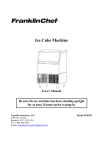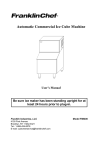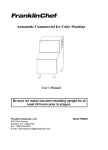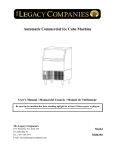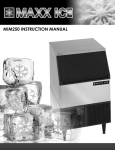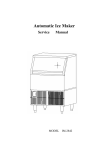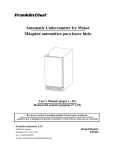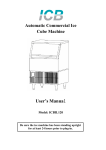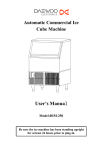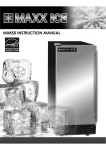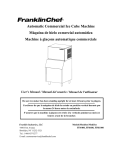Download Franklin Industries, L.L.C. FIM200 Ice Maker User Manual
Transcript
® Ice Cube Machine User’s Manual Be sure the ice machine has been standing upright for at least 24 hours prior to plug-in. Franklin Industries, LLC Model FIM200 4100 First Avenue Brooklyn, NY 11232-3321 Tel.: 1-888-424-8278 E-mail: [email protected] TABLE OF CONTENTS Page ICE MAKER SAFETY ................................................................................................ 2 IMPORTANT SAFEGUARDS ..............................................................................2 – 4 MAJOR FEATURES ................................................................................................... 4 TECHNICAL INFORMATION .................................................................................. 5 INTRODUCTION ....................................................................................................... 5 COMPONENT LOCATIONS ............................................................................................................... 6 ICE MAKER INSTALLATION .................................................................................................. 7 - 11 Unpacking ............................................................................................................. 7 Installing the Adjustable Feet.................................................................................. 7 Location Requirements ...................................................................................................................... 8 Installing the Stability Brackets.......................................................................... 8 - 9 Electrical Requirements ............................................................................................................ 9 - 10 Leveling the Ice Maker ....................................................................................................................10 Water Supply .............................................................................................................................. 10 - 11 Installation Types ................................................................................................. 11 OPERATION ...................................................................................................................................... 12 -14 Final Checklist before Operation .......................................................................... 12 Operating Method .................................................................................................................... 12 - 13 How the Machine Makes Ice .........................................................................................................13 Normal Sounds .......................................................................................................................... 13 - 14 Preparing the Ice Maker for Long Storage ...............................................................................14 CLEANING AND MAINTENANCE ................................................................. 14 - 19 Exterior Cleaning ................................................................................................. 15 Interior Cleaning ....................................................................................................................... 15 - 17 Water Distribution Tube Cleaning ..............................................................................................18 Ice-Making System Cleaning .............................................................................................. 18 - 19 CONTROL PANEL ........................................................................................................................ 19 - 20 TROUBLESHOOTING ................................................................................................................... 21-22 LIMITED WARRANTY ........................................................................................... 23 We reserve the right to make changes in specifications and design without prior notice. 1 ICE MAKER SAFETY Your safety and the safety of others are very important. We have provided many important safety messages in this manual and on your appliance. Always read and obey all safety messages. This is the Safety Alert Symbol. This symbol alerts you to potential hazards that can injure or kill you and others. All safety messages will follow the Safety Alert Symbol and either the words “DANGER”, “WARNING” OR “CAUTION”. DANGER means that failure to heed this safety statement may result in death or severe personal injury. WARNING means that failure to heed this safety statement may result in extensive product damage, serious personal injury, or death. CAUTION means that failure to heed this safety statement may result in minor or moderate All safety messages will alert you to what the potential hazard is, tell you how to reduce the chance of injury, and let you know what can happen if the instructions are not followed. IMPORTANT SAFETY INSTRUCTIONS WARNING: To reduce the risk of fire, electric shock or injury, when using your ice maker, follow these basic precautions: • Plug into grounded 3-prong outlet • Disconnect power before cleaning • Disconnect power before servicing • Do not remove grounding prong • Replace all panels before operating • Do not use an adapter • Use 2 or more people to move and • Do not use an extension cord install ice maker SAVE THESE INSTRUCTIONS IMPORTANT SAFEGUARDS Before the ice maker is used, it must be properly positioned and installed as described in this manual, so read the manual carefully. Franklin Industries strongly recommends that you have a professional install your new machine. The warranty may be affected or voided by an incorrect installation. To reduce the risk of fire, electrical shock or injury when using the ice maker, follow basic precautions, including the following: 2 • • • • • • • • • • • • • • • • • • • • • • • • • • • • Plug into a grounded 3-prong outlet. Do not remove grounding prong, do not use an adapter, and do not use an extension cord. It is recommended that a separate circuit, serving only your ice maker, be provided. Use receptacles that cannot be turned off by a switch or pull chain. Do not connect or disconnect the electric plug when your hands are wet. Never unplug the ice maker by pulling on the power cord. Always grip the plug firmly and pull straight out from the outlet. Never clean ice maker parts with flammable fluids. Do not store or use gasoline or other flammable vapors and liquids in the vicinity of this or any other appliance. The fumes can create a fire hazard or explosion. Before proceeding with cleaning and maintenance operations, make sure the power line of the unit is disconnected and the water line is shut off. (EXCEPTION: When cleaning the machine’s ice making and water systems, see pages 18 – 19.) Before operating, put all the enclosure panels back into their original places. Do not touch the evaporator with your hand when the machine is operating. Unplug the ice maker or disconnect power before cleaning or servicing. Failure to do so can result in electrical shock or death. Do not attempt to repair or replace any part of your ice maker unless it is specifically recommended in this manual. All other servicing should be referred to a qualified technician. Use two or more people to move and install ice maker. Failure to do so can result in back or other injury. To ensure proper ventilation for your ice maker, the front of the unit must be completely unobstructed. Choose a well-ventilated area with temperatures above 50ºF (10ºC) and below 100ºF (38ºC). This unit MUST be installed in an area protected from the elements, such as wind, rain, water spray or drips. The ice maker should not be located next to ovens, grills or other sources of high heat. The ice maker must be installed with all electrical and water connections in accordance with state and local codes. A standard electrical supply (115 VAC only, 60 Hz, 15 A), properly grounded in accordance with the National Electrical Code and local codes and ordinances, is required. Do not kink or pinch power supply cord or drain lines between ice maker and cabinet. The fuse (or circuit breaker) size should be 15 amperes. It is important for the ice maker to be leveled in order to work properly. You may need to make several adjustments to level it. All installations must be in accordance with local plumbing code requirements. Make certain that the hoses are not pinched or kinked or damaged during installation. Check for leaks after connection. Remove the packing materials and clean the ice maker before using. Turn on the water supply tap before switching on the ice maker. Never turn the water supply tap off when the ice maker is working. Except to take ice from the unit, keep the door closed in order to reduce ice melting and to promote proper ice formation. Although the unit has been tested at the factory, due to long-term transit and storage, the first batch of cubes must be discarded. If the ice maker will not be used for a long time, before the next use it must be thoroughly cleaned. Follow carefully any instructions provided for cleaning or use of sanitizing solution. Do not leave any solution inside the ice maker after cleaning. DO NOT touch the condenser fins. The condenser fins are sharp and can be easily damaged. DO NOT use solvent-based cleaning agents or abrasives on the interior. These cleaners may transmit taste to the ice cubes, or damage or discolor the interior. The ice machine cleaner contains acids. DO NOT use or mix with any other solventbased cleaner products. Use rubber gloves to protect hands. Carefully read the 3 • material safety instructions on the container of the ice machine cleaner. Do not use this apparatus for other than its intended purpose. SAVE THESE INSTRUCTIONS Electrical Connection Do not, under any circumstances, cut or remove the third (ground) prong from the power cord. For personal safety, this appliance must be properly grounded. The power cord of this appliance is equipped with a 3-prong grounding plug that mates with a standard 3-prong grounding wall outlet to minimize the possibility of electric shock hazard from the appliance. Have the wall outlet and circuit checked by a qualified electrician to make sure the outlet is properly grounded. When a standard 2-prong wall outlet is encountered, it is your responsibility and obligation to have it replaced with a properly grounded 3-prong wall outlet. The ice maker should always be plugged into its own individual electrical outlet which has a voltage rating that matches the rating label on the appliance. This provides the best performance and also prevents overloading house wiring circuits which could cause a fire hazard from overheated wires. Never unplug your ice maker by pulling on the power cord. Always grip the plug firmly and pull straight out from the outlet. Repair or replace immediately all power cords that have become frayed or otherwise damaged. Do not use a cord that shows cracks or abrasion damage along its length or at either end. When moving the ice maker, be careful not to damage the power cord. Extension Cord Because of potential safety hazards under certain conditions, it is strongly recommended that you do not use an extension cord with this ice maker. Major Features 1. Completely automatic operation. 2. The different colors of the LED display indicate various work modes. 3. The fan motor responds to the ambient temperature. If room temperature is low, the motor will stop working to keep the cooling system in good working condition. 4. Ice cube size is adjustable. 5. A sensitive probe and accurate timer enhance the performance of the ice maker. Technical Information Model: Electrical input: Power consumption: Ice-making/Ice-harvest rated current: Refrigerant: High/Low side pressure: Unit width x depth x height: Unit weight: Ice storage capacity: Ice-making capability: Ice shape: Ice cube dimensions: FIM200 115VAC ~ 60Hz 9.4 kW·h /100 lbs of ice 9.9A/13.3A R404a, 24.7 oz. 290psig/190psig 24” x 24” x 39” 144 lbs maximum 75 lbs maximum 200 lbs/day* Cube 1” x 1” x _” 4 *The actual quantity of ice produced per day can vary with room and water conditions. The technical data and performance index listed above should be used for reference only. They are subject to change. This product has been tested and certified to NSF standard 12 by NSF International. Introduction The Franklin Chef® FIM200 Ice Cube Machine produces hard, crystal-clear, gourmet cube ice, and offers convenience for homeowners and hotel guests. An insulated ice storage bin is built in. This user’s manual is intended as a resource for persons installing, using and servicing model FIM200. It contains valuable information on safety and maintenance. Franklin Chef® strongly recommends that this manual be kept in a place where it can be accessed when needed. Every Franklin Chef® Ice Cube Machine is designed and manufactured according to the highest standards of safety and performance. It meets or exceeds the safety standard of UL563 and sanitation standard NSF12. Franklin Industries, L.L.C, assumes no liability or responsibility of any kind for products manufactured by Franklin Industries, L.L.C., that have been altered in any way, including the use of any parts and/or other components not specifically approved by Franklin Industries, L.L.C. Franklin Industries, L.L.C. reserves the right to make design changes and/or improvements at any time. Specifications and designs are subject to change without notice. 5 Component Locations Top panel Door Evaporator (ice mold) Ice full probe Water tank Water tank screw nut Ice storage bin Front bottom louver Control panel cover Adjustable foot Top view Back view Water inlet Power supply line Drain hose Float Water pump Stability brackets Water supply hose Ice scoop 6 Ice Maker Installation Unpacking Remove packaging materials IMPORTANT: Do not remove any permanent instruction labels or the data label on your ice maker. Remove tape and glue from your ice maker before using, • To remove any remaining tape or glue, rub the area briskly with your thumb. Tape or glue residue can also be easily removed by rubbing a small amount of liquid dish soap over the adhesive with your fingers. Wipe with warm water and dry. • Do not use sharp instruments, rubbing alcohol, flammable fluids, or abrasive cleaners to remove tape or glue. These products can damage the surface of your ice maker. • Leave lowermost foam panel in place until after the adjustable feet are attached. 45 Installing the adjustable feet 4 Cleaning before use After you remove all tape and glue from the machine, clean the inside of your ice maker before using it. See “Interior Cleaning” in the Cleaning and Maintenance section. At least two persons are required to install the adjustable feet. You will find four adjustable feet packed in the ice storage bin. To install, tilt one side of the unit and screw in two adjustable feet, as illustrated. (IMPORTANT: Do not tilt the unit more than 45º.) Then tilt the other side and screw in the remaining two feet. Lower foam panel 7 Location Requirements This ice maker should be installed by qualified personnel. NOTICE: 1. Before setting the ice maker inside a cabinet, connect the water supply pipe correctly. Untie the drain hose, insert it into the drain, and connect the power supply line. 2. Do not kink or pinch the power supply line between the ice maker and wall or cabinet. Installation clearance Top view Side view Rear Front Installing the stability brackets This operation requires at least two persons. If you wish to install the ice maker in a free-standing mode rather than enclosed, it is necessary to attach the two metallic stability brackets that can be found packed inside the ice storage bin. Keeping the machine tilted to the right, but not more than 45ß, attach one bracket to the center of the underside of the ice maker with two screws (supplied). See illustration below. Set the unit back on its four feet, then tilt it forward in order to screw in the second bracket on the underside of the unit opposite the first bracket. Level the ice maker. This operation will stabilize it for free-standing operation. • To ensure proper ventilation for your ice maker, the front of the unit must be completely unobstructed. 8 • • • • • When installing the ice maker under a counter, follow the recommended spacing dimensions shown. Allow at least 2/5_ (10 mm) clearance at rear, 1/5” (5 mm) at the sides and 1_ (25 mm) at the top for proper air circulation. The installation should allow the ice maker to be pulled forward for servicing if necessary. Choose a well-ventilated area with temperatures above 50ºF (10ºC) and below 100ºF (38ºC). This unit MUST be installed in an area protected from the elements, such as wind, rain, water spray or drips. The unit should not be located next to ovens, grills or other sources of high heat. Installation of the ice maker requires a cold water supply inlet of 1/4_ (6.35 mm) soft copper tubing with a shut-off valve. The ice maker requires a continuous water supply with a minimum pressure of 15 psig and a static pressure not to exceed 80 psig. The temperature of the water feeding into the ice maker should be between 41ºF (5ºC) and 90ºF (32ºC) for proper operation. • In general, it is always a good idea to filter the water. A water filter, if it is of the proper type, can remove taste and odors as well as particles. • The ice maker must be installed with all electrical and water connections in accordance with state and local codes. • The unit should be located on a firm and level surface. It is important for the ice maker to be level in order to work properly. If needed, you can adjust the height of the ice maker by rotating the feet. See the Leveling the Ice Maker section. Electrical Requirements Before you move your ice maker into its final location, it is important to make sure you have the proper electrical connection. A standard electrical supply (115 VAC only, 60 Hz, 15 A), properly grounded in accordance with the National Electrical Code and local codes and ordinances, is required. The ice maker should always be plugged into its own individual electrical outlet. It is recommended that a separate circuit, serving only your ice maker, be provided. Use receptacles that cannot be turned off by a switch or pull chain. The fuse (or circuit breaker) size should be 15 amperes. 9 Recommended grounding method For your personal safety, this appliance must be grounded. It is equipped with a power supply cord having a 3-prong grounding plug. To minimize possible shock hazard, the cord must be plugged into a mating 3-pronged and grounding-type wall receptacle, grounded in accordance with the National Electrical Code and local codes and ordinances. If a mating wall receptacle is not available, it is the personal responsibility of the customer to have a properly grounded, 3-prong wall receptacle installed by a qualified electrician. Leveling the Ice Maker Once the ice cube machine is set in its enclosure, if the base is not level, you can adjust the feet by rotating the under block (see below) until the machine is level. Under block Turning the under block clockwise increases the machine’s height Turning the under block counter-clockwise reduces the machine’s height It is important for the ice maker to be leveled, or water may not flow properly through the evaporator (ice mold). Ice production will be lower than normal, and operation will be noisy. Adjust the height of the under block of the adjustable foot, rotating it to the right (counter- clockwise) to lower that side of the ice maker. Turning the under block to the left (clockwise) raises that side of the ice maker. Water Supply The water supply should be ready at the point of installation. The water supply pressure should be a minimum of 15 psig with a static pressure not more than 80 psig. (A wall outlet directly behind the ice maker will make installation easier.) IMPORTANT: 1. All installations must be in accordance with local plumbing code requirements. Professional installation is recommended. 2. Make certain that the hoses are not pinched or kinked or damaged during installation. 3. Check for leaks after connection. Tools required: __ open-end wrench, Phillips screwdriver Connecting the water line: 1. Turn off main water supply. 2. Find a __ to __ vertical water pipe near the installation location. The distance should be less than 9 feet. The water supply hose provided with the ice maker is about 9 feet long. 3. A shut-off valve must be installed to the main water supply. If the water pipe has a plain piece of copper tubing, attach a __O.D. compression union to the tubing and 10 remove the nut. 4. Connect nuts of the water supply hose to tap and water inlet valve. Tighten firmly by hand, then one-half turn with wrench. 5. Turn on main water supply and tap. Check for water supply connection leaks. Tighten every connection (including connections at the water inlet). Installation Types This ice cube machine has been designed to be enclosed (as under a cabinet). It can also be free-standing (using the supplied stability brackets) or built-in (sealed to the floor). In every case, there must be adequate air space around the unit for ventilation purposes (see diagrams on page 8). Enclosed Installation: An enclosed installation will allow you to install the ice cube machine under a counter or in a kitchen cabinet provided the required clearance space around the ice maker is respected. You must follow the stated instructions for a. Electrical requirements b. Water supply Free-standing Installation: The ice cube machine can be installed to be free-standing in any place you desire provided you have access to a water supply. This installation has the same requirements as an enclosed installation, plus you must also follow the stated instructions for Installing the Stability Brackets. Built-in Installation: If this method of installation is chosen, it will still be necessary to allow adequate ventilation space around the unit. The following additional items must be observed. 1. Place the ice cube machine in front of the installation location. Raise the machine and place it on the floor or on a platform depending on your installation requirements. 2. The water supply line must be plumbed before connecting to the ice maker. 3. Turn on the main water supply and tap. Check for water supply connection leaks. Tighten every connection (including connections at the water inlet). 4. If the electrical outlet for the ice maker is behind the cabinet, plug in the ice maker. 5. Push the ice maker into position. 6. Seal all around the cabinet to the floor with an approved caulking compound. Operation Final Check List before Operation 1. Have all packing materials and tape been removed from the interior and exterior of the ice maker? 2. Did you clean the ice storage bin? (See pages 15 - 17.) 3. Have the installation instructions been followed, including connecting the machine to water and electricity? 4. Has the machine been leveled? 5. Is the ice cube machine in a site where the ambient temperature is between 50º F (10º C) and 100º F (38º C) and the water temperature between 41º F (5º C) and 90º F (32º C) all year round? 6. Has the water supply pressure been checked to ensure a minimum of 15 psig with a static pressure not to exceed 80 psig? 7. Is there a clearance of at least 2/5_(10 mm) at the rear, 1_(25 mm) at the top and 1/5_ (5 mm) at the sides for proper air circulation? 8. Has the power supply voltage been checked or tested against the nameplate rating? And has proper grounding been installed for the ice cube machine? 9. Is the ice cube machine plugged in? 10. Have you turned on the main water supply and the tap? 11 11. Have you checked for leaks at all water supply connections? Operating Method 1. Turn on the water tap, letting the water enter the water tank, then turn the power switch ON. The power switch’s indicator lamp lights, as well as the other three indicator lights on the control panel. 2. After about 3 minutes, the ice maker will automatically proceed to the ice-making stage, and the sound of flowing water will be heard. Only the red power switch lamp and the green Ice Making LED will be on. 3. When the batch of ice has been fully formed, ice will automatically fall into the ice storage bin. The yellow Ice Harvest LED will be on, and the other two will be off. 4. When the ice storage bin is full, the sheet of cubes will not fall completely and will hold the ice-full probe open. The machine is in the ice-full mode, and the red Ice Full LED will be lit. The other two LEDs will be off. 5. The unit starts making ice again after the ice cubes are removed. At the same time, the ice-full probe swings back to operating position. Ice-making stage Ice harvest stage IMPORTANT: • Although the unit has been tested and cleaned at the factory, due to long-term transit and storage, the first batch of cubes must be discarded. • Never turn the water supply tap off when the ice maker is working. • Never touch the evaporator when the machine is running. • Except to take ice from the unit, keep the door closed to reduce melting and insure proper ice formation. How the Machine Makes Ice When the power switch is first turned ON, the machine is in Stand-by mode. After about 3 minutes, it will automatically proceed to the ice-making stage. There are two distinct cycles: Freeze and Harvest. During the Freeze cycle, water flows to the evaporator surface. In the Harvest cycle, the ice is released and water enters the machine. A complete cycle can take 15 to 40 minutes, depending on ambient temperature and operating conditions. Freeze: During the Freeze cycle the compressor is pumping refrigerant, the fan motor is fully formed, the ice maker stops the Freeze cycle and begins the Harvest cycle. Harvest: During the Harvest cycle the compressor is still operating, but the water pump has stopped. The hot gas valve opens, diverting hot refrigerant gas into the evaporator. The gas warms the evaporator, causing the cubes to slide as a unit off the evaporator and into the storage bin. The Freeze cycle will restart when all the cubes drop into the bin. How the machine uses water: 12 The ice cube machine begins with a fixed charge of water that is contained in the water tank. As the water flows to the freezing evaporator surface, the water will freeze and stick to the ice cube molds. During the ice-making process, fresh water enters the water tank continuously as the water from the trough freezes continuously on the evaporator. Evaporator Water inlet Water pump Hot gas valve Water tray (trough) Compressor Condenser Fan motor Normal Sounds Your new ice cube machine may make sounds that are unfamiliar to you. Most of the new sounds are normal. Hard surfaces like the floor and walls can amplify the sounds. The following describes the kinds of sounds that might be new to you and what may be causing them. • Rattling noises may come from the flow of the refrigerant or the water line. Items stored on top of the ice cube machine can also make noises. • The high-efficiency compressor may make a pulsating or high-pitched sound. • Running water may make a splashing sound. • You may hear air being forced over the condenser by the condenser fan. • During the Harvest cycle, you may hear the sound of ice cubes falling into the ice storage bin. Preparing the Ice Cube Machine for Long Storage If the ice cube machine will not be used for a long time, or it is to be moved to another place, it will be necessary to drain the system of water. 1. Shut off the water supply at the main water source. 2. Disconnect the water supply line from the water inlet. 3. Shut off the power supply at the main electrical power source. 4. Screw off the water tank screw nut and drain out water completely, then tighten the nut after finishing. Dry the tank. 5. Take out the ice storage bin to remove ice. (See pp. 16-17.) Dry and replace the bin. 6. Leave the door open to allow for circulation and to prevent mold and mildew. 7. Leave the water supply line and power cord disconnected until ready to reuse. IMPORTANT: ¥ Do not touch the power plug when your hands are wet. ¥ Never unplug the unit by pulling on the cord. Cleaning and Maintenance 13 Periodic cleaning and proper maintenance will ensure efficiency, top performance, and long life. The maintenance intervals listed are based on normal conditions. You may want to shorten the intervals if you have pets or there are other special considerations. What shouldn’t be done Never keep anything in the ice storage bin other than ice: objects like wine and beer bottles are not only unsanitary, but the labels may slip off and plug up the drain. What should be kept clean There are 4 things to keep clean: 1. The exterior 2. The interior 3. Water distribution tube 4. The ice-making system Exterior Cleaning The door and cabinet may be cleaned with a mild detergent and warm water solution such as 1 oz of dishwashing liquid mixed with 2 gallons of warm water. Do not use solvent-based or abrasive cleaners. Use a soft sponge and rinse with clean water. Wipe with a soft clean towel to prevent water spotting. Clean stainless steel with a cloth dampened with a mild detergent and warm water solution. Never use an abrasive cleaning agent. Interior Cleaning The ice storage bin should be sanitized occasionally. Clean the water tank before the ice cube machine is used for the first time and reused after stopping for an extended period of time. It is usually convenient to sanitize the trough after the ice-making system has been cleaned and the ice storage bin is empty. 1. Disconnect power to the unit. 2. Open the door. You will find the water tank screw nut on the front right of the water tank. Screw off the nut and drain water completely into the ice storage bin. The water drains out of the machine through the drain hole in the bin. NOTE: Don’t forget to screw the nut back into place again. 3. Using a sanitizing solution made of 1 ounce of household bleach and 2 gallons of hot water (95º to 115ºF), wipe down the water tank and the inside of the ice storage bin 14 with a clean cloth. To clean hard-to-reach corners, apply the sanitizing solution with a spray bottle. 4. Rinse thoroughly with clear water. This completes the routine interior cleaning of the unit. 5. Reconnect the power. The ice scoop should be washed regularly. Wash it just like any other food container. For a more thorough cleaning of the interior, the ice storage bin must be removed. This will allow cleaning of the vertical channels on both sides of the evaporator (ice mold) and the sides of the ice storage bin that are not normally accessible. Wipe these surfaces with the sanitizing solution. To remove the ice storage bin for thorough cleaning and for servicing, follow these steps: 1. Remove the front grill a. Unscrew the front bottom louver and carefully lower the louver. b. You will find some electrical wires connected to the back of the louver, behind the 15 2. Remove the ice storage bin a. After removing the bottom louver, look for two screws under the slide way (see illustration). Unscrew the two screws. b. Unscrew and remove the top panel. c. Remove the drain hose at the back of the machine by unscrewing the hose connector. 16 d. Slide out the ice storage bin for cleaning and/or servicing. Water Distribution Tube Cleaning When you find that the ice cubes are incompletely formed or the output of ice cubes is low, the water distribution tube may be blocked. Set the power switch to OFF. Unscrew the four screws holding the top panel and remove the panel. You will see the water distribution tube. Rotate the water distribution tube so that the holes in it are facing up. Using a toothpick or similar tool, dredge the holes, then rotate the water distribution tube back to its original position. If the tube is badly blocked, clean it as follows: 1. Shut off the water and power supplies. 2. Disconnect the water hose from the distribution tube. 3. Lift one side, remove the distribution tube. 4. With a brush, clean the tube with a dilute solution of warm water and a mild detergent such as dishwashing liquid. After removing the dirt and lint from the surface, rinse the tube with clean water. 5. Replace the distribution tube. 6. Reconnect the water supply and power supply lines. 17 7. Re-attach the top panel. Ice-Making System Cleaning Minerals that are removed from water during the freezing cycle will eventually form a hard, scaly deposit in the water system. Cleaning the system regularly helps remove the mineral scale buildup. How often you need to clean the system depends on how hard your water is or how effective your filtration may be. With hard water of 15 to 20 grains/ gallon (4 to 5 grains/liter), you may need to clean the system as often as every 3 months. 1. Set the power switch to OFF. 2. Remove all ice cubes from the storage bin. 3. Keep the ice maker connected to the water supply. Pour 8 oz. of Nickel-Safe Ice Maker Cleaner Solution into the water tank. 4. Turn the power switch ON. Within 3 minutes, press the CLEAN button. The machine will run the Automatic Clean mode. The yellow Ice Harvest and the red Ice Full LEDs will blink. 5. The cleaning cycle will continue for 30 minutes unless you press the power switch (you can press the power switch to stop the cleaning cycle any time during the 30 minutes). After cleaning, the yellow Ice Harvest and the red Ice Full LEDs go on steady and the machine returns to Stand-by mode. 6. The dirty water must be drained out completely. Perform steps 2 and 3 in the Interior Cleaning section. 7. Repeat steps 3 to 6 above three times to rinse the ice-making system completely. NOTE: Do not add Ice Maker Cleaner Solution to the water trough during the rinses. 8. If you want to make ice cubes after cleaning, turn off the power switch, drain off the waste water, then turn on the power switch. The next ice-making cycle will begin. 9. Discard the first batch of ice. Control Panel (located at left side of front bottom louver panel) 18 Push the control panel cover to open it. The control panel includes one power switch, one button, one adjustable screw and four indicator lights. Operating procedure: 1. When plugging in and turning on the power switch, the power indicator and other three indicator lights are all on. 2. After 3 minutes for water inlet, the ice machine will start to make ice automatically. Only the power and ice-making indicators will be on. 3. During harvesting, the harvest indicator light is on and the ice-making indicator is off. When the ice storage bin is full, only the ice-full indicator and power indicator are on. 4. If the Clean button is pressed during the ice-making mode, it will be ignored. The ice-making will continue. 5. When you want to clean the machine, turn off the power switch first, then turn it on again. Press the Clean button within 3 minutes and the ice maker will start the cleaning mode, with harvest and ice-making indicators blinking. After 30 minutes, the cleaning mode stops and the harvest indicator and ice-making indicators are on steady. If you want to restart the ice-making process after cleaning, turn off the power switch first and drain the waste water, then turn on the power switch again and the machine will automatically go into the ice-making process. 6. If you want to interrupt the cleaning mode before it is finished, do not press the Clean button again. Instead, turn the power switch off. This stops the cleaning mode. 7. If the machine is on but only the power indicator light is lit, this may indicate that not enough water is reaching the system, that the water pump is not functioning, or some similar problem. First check the level in the water tank, then examine the water pump, etc. 8. If the unit is connected to the power supply but no visual indicator lights up when the power switch is turned on, the fuse in the control panel box may need to be replaced. Descriptions of LEDs and buttons: 1. Ice Full (white) LED: Ice Full indicator light When this LED is on, the ice storage bin is full of ice cubes or there is something obstructing the ice-full probe. The unit will stop working. When ice cubes are removed from the ice storage bin, clearing the ice-full probe, the white LED will flash for 3 minutes. Then the unit will restart and return to the ice-making mode. 2. Ice Making (Green) LED: Ice Making indicator light When this LED is on, the unit is working in the ice-making mode. When the green LED is flashing, the unit is working in the ice-making mode but approaching the ice harvest mode. 19 3. Ice Harvest (Yellow) LED: Ice Harvest indicator light When this LED is on, the unit is working in the ice harvest mode controlled by the ice-full probe. 4. I. S. Adjust screw: Ice size adjustment Turn the screw clockwise and the size of individual ice cubes will be larger in the next cycle; the cycle time will be longer. Turn the screw counter-clockwise, and the ice cube size will be smaller in the next cycle. 5. Power switch This is the main switch. When it is turned on, the unit goes into Stand-by mode for about 3 minutes, with all LEDs on, then starts to make ice cubes automatically, switching between ice-making and ice harvest modes. 6. CLEAN button While the unit is in Stand-by mode (all LEDs on steady), you can press CLEAN to start the Automatic Clean procedure. The green and yellow LEDs will flash together. NOTE: When you finish working with the control panel, close the cover. IMPORTANT: It is recommended that the ice cube size not be adjusted more often than necessary since this could damage the machine’s controls. • Avoid letting water contact the control box. • When you finish working with the control panel, close the cover. • 20 Troubleshooting Before Calling for Service If the unit appears to be malfunctioning, read through the OPERATION section of this manual first. If the problem persists, check the Troubleshooting Guide below and on the following page. The problem may be something very simple that can be solved without a service call. ON. air screen. 21 22 23 Limited Warranty Franklin Industries, LLC, warrants this product to be free from defects in materials and workmanship for a period of one year from the date of the original purchase or delivery. Any parts that are determined to be defective will be replaced or repaired, at its sole discretion, by Franklin Industries, L.L.C., at no charge as long as it has been determined that the unit was operated in accordance with the instructions attached or furnished with the product. If the unit proves to be defective, your first course of action should be to follow the retailer’s return policy. This warranty covers units only in the continental United States and does not cover the following: • • • • • • Damage from improper voltage or installation Damage in shipping Defects other than manufacturing defects Any installation expenses that may be incurred Labor or repairs after the initial 12-month period Damage from abuse, misuse, accident, alteration or lack of proper care or maintenance • Improper or incorrectly performed maintenance or repairs • Use of parts not recommended by Franklin Industries, L.L.C. • Damage due to acts of God. This limited warranty is given in lieu of all other warranties expressed or implied. This warranty does not cover incidental or consequential damages. Some States do not allow the exclusion or limitation of incidental or consequential damages, so the above limitation or exclusion may not apply to you. This warranty provides you with specific legal rights and you may have other rights which vary from State to State. Consult the written materials accompanying your product for the safe and proper operation. This warranty may not be assigned. For warranty service, contact: Franklin Industries, L.L.C. 4100 First Avenue Brooklyn, NY 11232-3321 Tel.: 1-888-424-8278 E-mail: [email protected] When service is required, have on hand the Model and Serial numbers found on the rating label on the back of the unit, as well as proof of purchase such as a sales or gift receipt. FIM200 OM-E-1 Printed in China 24

























